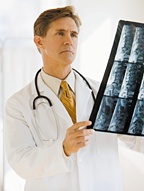To Your Health
March, 2008 (Vol. 02, Issue 03) |
|
|
Hippocrates (460-380 BC), the Greek father of medicine, had a rather robust treatment for scoliosis. Since straightening the spine seemed to be his goal, he would first suspend a long board between two roofs and have the patient position themselves in the middle, with a rope tied underneath the arms and around the chest. Then, with the other end of the rope tied to the board, Hippocrates would push the patient off. Historical texts do not comment on the effectiveness of this method, nor do they tell of any injury actually suffered by Hippocrates from a vindictive patient.
Instead of that dubious method, a better physical treatment approach for scoliosis is chiropractic manipulation. But the idea of hands-on treatment can be confusing. There are many case studies that show actual improvement of modest curvatures with manipulation. However, chiropractors do not claim to "straighten the spine" in the more challenging scoliosis cases. What often is very important in treatment is improving function of the spinal movements, and nerve irritation of large nerves or pain in the nerves of the vertebral joints.
In cases of scoliosis, chiropractic physicians are front-line doctors in maintaining proper motion and function of the spinal joints or vertebrae. There are two general categories of techniques used in these cases. One is the hallmark joint manipulation or adjustment, which stretches the joint tissue and releases joint pressure wherever individual vertebrae are locked or fixed. A second category includes muscle and tendon techniques, usually using deep pressure, friction or pinpoint stimulation.
 Scoliosis patients often have problems just fighting gravity. Since the curves can load one side of the body more than the other, muscles shorten on one side and overstretch on the other. Chiropractic muscle techniques create more elasticity in these muscles, thus relieving pain. Joint adjustments restore proper motion. Both of these approaches can be valuable when the large nerves down the arms or legs are pinched, crowded or irritated.
Scoliosis patients often have problems just fighting gravity. Since the curves can load one side of the body more than the other, muscles shorten on one side and overstretch on the other. Chiropractic muscle techniques create more elasticity in these muscles, thus relieving pain. Joint adjustments restore proper motion. Both of these approaches can be valuable when the large nerves down the arms or legs are pinched, crowded or irritated.
When scoliosis is severe, chiropractic treatment is even more important because of the threat of muscle and joint degeneration that insidiously occurs over time. One cause of mild to moderate scoliosis is when one leg is shorter than the other. Chiropractic doctors are especially trained to deal with complications of curvatures associated with leg inequality. Sometimes one leg can be shorter (an inch or more) congenitally, with the associated curvature noted especially with standing. But a lesser known, yet common problem is a functional short leg. This is when locking and fixation of spinal joints, or muscle imbalance, actually causes or aggravates a mild scoliosis. Chiropractors are the best practitioners to identify and correct this problem.
So, whether it's your children or yourself, when there are questions regarding "funny" curves or imbalances in posture, consult your doctor of chiropractic. And if treatment is appropriate, it will certainly be better than being pushed off a board with a rope tied on your feet. No offense to Hippocrates.
John Hanks, DC, is a board-certified chiropractic orthopedist and is certified as a chiropractic sports physician. He currently serves as the senior chiropractic consultant in the Department of Complementary Medicine, Kaiser Permanente, Rocky Mountain Region.

